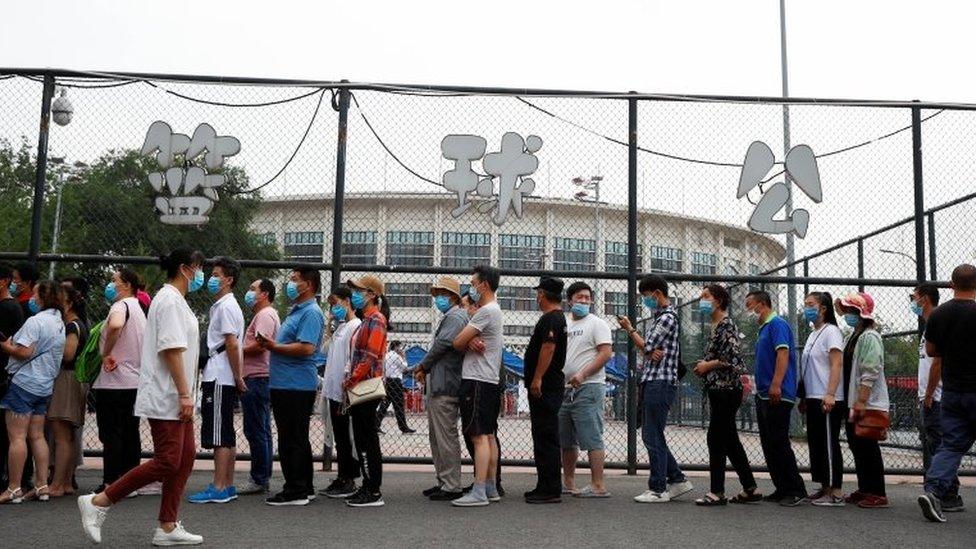Coronavirus in Beijing: 27 neighbourhoods not allowed to leave as spike continues
- Published

People queuing for a nucleic acid test on Wednesday - most people need a negative test before leaving the city, while others are banned entirely
Millions of people in Beijing are living under renewed restrictions, as a spike in virus cases continues.
The city reported another 31 cases on Wednesday, bringing the total to 137 in the past week.
Before the recent spike, the Chinese capital had gone 57 days without a locally-transmitted case.
The outbreak is believed to have started in the massive Xinfadi food market that supplies 80% of the city's meat and vegetables.

What are the new restrictions?
At least 27 neighbourhoods have been classed as medium risk and one neighbourhood, near the market, is high risk.
People in medium or high-risk areas cannot leave the city. People in low-risk areas can leave, but need to test negative first.
However, getting a test is difficult - three testing stations told the BBC there were no tests available until July. Queues were seen outside other centres.
More than 1,200 flights have been cancelled to and from the city and railway services have been reduced until at least 9 July.
Primary school, middle school, and college classes are suspended, sports teams cannot play, and swimming pools and gyms are closed.
However, roads are open, and companies and factories can still work. The city is on a "level two" alert, the second-highest.

Normal-ish...then bam!

Restaurants, sport, packed trains, even the pub… there we were, basking in the glory of "normal-ish" life in Beijing, after more than 50 days without an infection.
Then: bam!
The market outbreak has dragged us back into a virus prevention bubble.
In effect, it's very hard to leave Beijing right now. If you haven't done a test in the past week your departure is not allowed, and limited testing capacity is, understandably, being diverted to "high risk" groups.
The airlines know this. That's why they've cancelled 1,255 flights in and out of the capital on Wednesday so far.
For the moment, the authorities are managing Beijing districts almost like cities within the city, imposing strict measures where needed in the hope that they can control it.
However, this is touching everyone's movements.
The main difference between now and February is that businesses, government departments, manufacturing are all still operating.
Perhaps because of this, there seems to be a general confidence that the cluster will be controlled - before becoming a full-blown second wave.

Where did the outbreak begin?
Local media said the virus was discovered on chopping boards used for imported salmon at the Xinfandi market.
The general manager of the market was dismissed, along with other local officials.
The Beijing government said "relevant people" from the market would not be allowed to leave the city, regardless of which neighbourhood they live in.
The market has tens of thousands of visitors each day.
What is the situation in the rest of China?
In general, China has successfully "flattened the curve" in recent months.
After passing 80,000 confirmed cases at the start of March, it has added only around 3,200 since then.
On Tuesday, for example, it reported just 32 locally-transmitted cases, external in the whole country - 27 were in Beijing with four in neighbouring Hebei.
Paul Adams asks whether China is being bolder in the wake of the pandemic

Do you live in one of the 27 Beijing neighbourhoods where restrictions are in place? Share your experiences by emailing haveyoursay@bbc.co.uk, external.
Please include a contact number if you are willing to speak to a BBC journalist.
WhatsApp: +44 7756 165803
Tweet: @BBC_HaveYourSay, external
Send pictures/video to yourpics@bbc.co.uk, external
Please read our terms & conditions and privacy policy